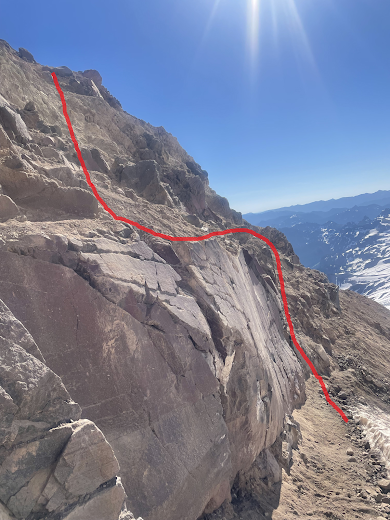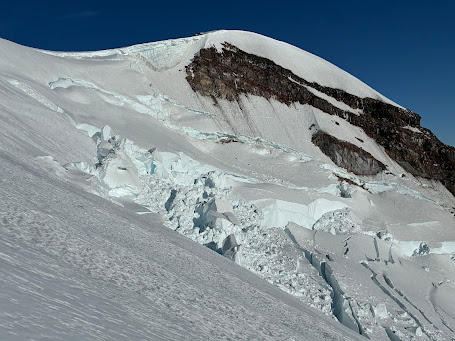It has been sunny and hot up here as we head into mid-July. Freezing levels this past week have been steady in the 15-17k' range and the forecast for the next week looks similar. This extended warm weather and the high sun angle of mid-summer create dynamic conditions on the upper mountain with little to no refreeze at nights. This leads to punchy snow, weak crevasse bridges, and new cracks opening daily. Climbers should approach all crevasses with extra caution and plan to leave early, avoiding the heat of midday when the snow is weakest.
Disappointment Cleaver
The route remains much the same as described in our previous DC blog from 7/9, so be sure to check that out for more info. Here are some photos from an ascent a few days later on 7/12:
 |
| Looking down from Dunn's Roll near 10,600' on the east side of Cathedral Gap |
 |
| The ladder at High Crack near 11,400' |
 |
| Looking back at the 11,400' traverse under the Ice Box and Bowling Alley to access the cleaver. Teams are encouraged to move quick through this section of high overhead hazard. |
 |
| Penitentes above the cleaver. |
 |
| The ladder at 12,900'. The boot pack splits just above this ladder where teams can choose the right or left variation. |
 |
| The ladder at 12,900' on the right variation. Note the serac hazard after the ladder, above the traverse towards the Emmons shoulder. |
 |
| Widening crevasse and thin bridge at the end of the 12,900' traverse to the Emmons Shoulder. Right Variation |
 |
| Mt. Rainier casts a long shadow |
Additional considerations
-It is always a good idea for teams of two to carry 2 pickets per person, and teams of 3 or more to have at least one picket per person, especially when building anchors for crevasse rescue in slushy snow.
-Prepare for and prevent the possibility of heat injuries like heat exhaustion and heat stroke by staying hydrated, avoiding climbing in the hottest times of day, and taking more rests as needed to prevent overheating.
-Never split up with your teammates or leave someone behind. If some needs to turn around, it is the responsibility of the entire team to facilitate that, the well-being of your teammate is more important than the summit. Furthermore, if splitting up leaves someone solo, that is a permit violation. Soloing requires a specific solo permit application and approval.
-The Public Shelter remains closed till ~9/30/2025 for maintenance. As always, even when the public shelter is open, come prepared with your own tent.






.png)

.png)






